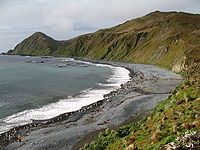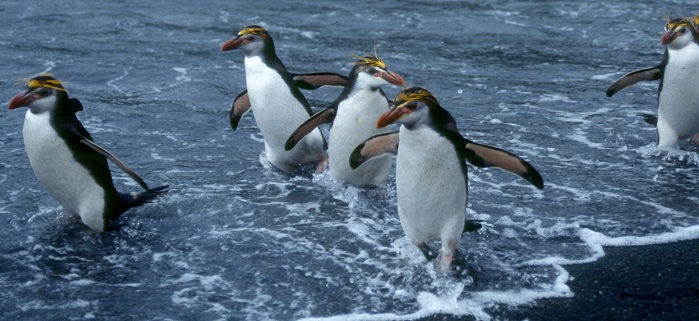Habitat
The Eudyptes schlegeli otherwise known as the Royal Penguin are
flightless birds that prefer a colder habitat to live in and
reproduce. The
majority of the time throughout the year, the
Eudyptes schlegeli
tend to live in the waters between Macquarie Island and
Antarctica where they feed on fish and krill as well as other
crustaceans (A-Z Animals. 2013.)
The waters
surrounding the Antarctic are perfect for
these aquatic birds
 because of the colder water and the
closeness of the mostly unpopulated island of Macquarie where
the birds exclusively enjoy nesting.
Because of the harsh conditions surrounding Macquarie
island and the rest of the region near Antarctica, humans and
many land based predators are not very present (A-Z Animals.
2013.) The living
environment limits predators of the Royal penguins to just
leopard seals, large sharks, such as the
Great White, and killer whales.
The only real predators that the penguins have ever had
difficulty with is humans hunting them in order to use them for
oil (Australian Government Department of the Environment. 2014.)
because of the colder water and the
closeness of the mostly unpopulated island of Macquarie where
the birds exclusively enjoy nesting.
Because of the harsh conditions surrounding Macquarie
island and the rest of the region near Antarctica, humans and
many land based predators are not very present (A-Z Animals.
2013.) The living
environment limits predators of the Royal penguins to just
leopard seals, large sharks, such as the
Great White, and killer whales.
The only real predators that the penguins have ever had
difficulty with is humans hunting them in order to use them for
oil (Australian Government Department of the Environment. 2014.)
The penguins can be found mostly in the waters
surrounding Antarctica (Hindell et al. 2012), New Zealand, and their
only known place for reproduction is found on Macquarie Island, south of Australia.
(Holmes. 2007.) They prefer
this location in the middle of Australia and Antarctica because of the
climate and terrain of the island.
The climate of Macquarie Island is quite stable with a very small
change of temperature and large amounts of wind.
The temperature of the island averages 49 degrees Fahrenheit
around January to 41 degrees Fahrenheit on average in July (Commonwealth
of Australia. 2014.) The
terrain is kept very smooth due to the frequent and very strong winds
that blow daily. The average
wind speed for the months of March to May as well as August to October,
(the two windiest parts of the year) can reach wind speeds of up to 50
miles per hour with a year round average of 18.6 miles per hour
(Commonwealth of Australia. 2104.)
The wind blows a large amount of water from the surrounding ocean
onto the island causing large amounts of humidity but sweeps away any
large piles of snow that could build up which the penguins enjoy because
they prefer a smooth terrain.
The Island also has a very unique method of creation being one of
the only subantarctic islands that is totally oceanic in origin and is
believed to have entirely risen out of oceanic crust (Roberts. 200.)
The Eugyptes schlegeli
require this kind of habitat for their nest building when they are
reproducing, the birds prefer open and accessible nests that are close
to the ocean. They also tend
to build nests in groups which is why a very large island with smooth
beaches such as Macquarie is such an ideal location for them to live and
reproduce.

.jpg)